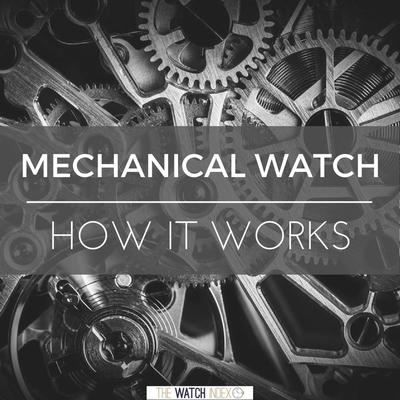How a Mechanical Watch Works

How a Mechanical Watch Works
The average timepiece is 40 to 42mm wide and 10 to 12mm thick, yet it holds an entire mechanism that accurately tells time. Modern-day watches can withstand temperature changes, position changes, and magnetic fields with only a few seconds of deviation. Ever wonder how that’s possible?
There’s quite a few components that go into making a mechanical watch. You have the springs, the barrels, the pinnons, the bearings, the jewels, the gears, and so much more. These components fit together to create the mechanical movement.
Today we’ll be looking at the inner workings of a hand-wound mechanical movement.
First let’s keep it simple with the four necessary components:
1. A source of energy
2. The means of transmitting the power
3. A way to control the power
4. A dial to record the power
Table of Contents
A Source of Energy
The mainspring is found in the mainspring barrel and it is the driving force that runs the watch. Depending on the watch’s power reserve, the mainspring can hold the energy at least one full day while some of the newer watches have up to an eight-day power reserve.
The Means of Transmitting the Power
When a wearer winds the crown, the watch’s mainspring is tightened via the winding stem. This tightening creates the power to initiate the watch’s mechanism.
A Way to Control the Power
The balance wheel controls the power, and it’s necessary for a mechanical watch. The balance wheel rotates back and forth on an axle. The balance spring, also known as the hairspring, is a very fine spring that returns the balance wheel back to its neutral position. The spring’s elasticity ensures that the balance swings back and forth at a regular rate. Without a well-constructed balance, the watch will not be precise.
Although the mainspring and the balance wheel are two of the most important components, the watch will not properly work without the pallet, jewel pins, escape wheel, and gear train. Without these components, a watch would use up its energy in just a few short moments. To prevent this from happening, you need the entire mechanism to work together to save energy.
In a simplified form, the mainspring connects to the gear train, the gear train connects to the pallet, the pallet connects to the escapement, and the escapement connects to the balance wheel. Now that you know the order, let’s figure out the purpose for each component.
The gear train helps transmit the power to the balance wheel. A partial turn of the mainspring drives the center wheel a full revolution. Then a partial turn of the center wheel drives the third wheel a full revolution. In turn, the third wheel drives the fourth wheel many revolutions. Finally, the fourth wheel drives the escape wheel. In the end, you only need a partial rotation of the mainspring barrel to drive the escape wheel many many rotations. This is how the watch conserves energy.
The escape wheel, also known as the escapement, is the device that controls the rotation of the wheels. You may be wondering why the escape wheel doesn’t just constantly turn. The escape wheel is connected to the balance spring by the pallet level. The pallet lever controls how quickly the escapement turns. The pallet includes two pallet jewels that catch on the teeth of the escapement. This regulates when the escapement moves forward a notch. The balance wheel, as stated before, rotates back and forth on an axle with the help of the balance spring that returns the balance wheel back to its neutral position. As the balance wheel rotates back and forth, it moves the jewel pins back and forth as well. As the jewel pins rotate, they release one on the escapement’s teeth and catch another one, preventing it from constantly spinning.
A Dial to Record the Power
Now you know how the mechanism works, you’re probably wondering how this all connects to telling time. Remember the gear train that we talked about before? Watchmakers affix the seconds hand to the fourth wheel. As the escapement moves 5 ticks, the seconds hand moves one graduation on its dial. The minute hand is affixed to the center wheel. As the seconds hand moves 60 graduations, the minute hand moves one. The hour hand is also placed on the center wheel. In a traditional watch, this hand makes a full rotation every 12 hours.
The rotation of the balance wheel determines how quickly the seconds hand rotates. If the balance wheel is not accurate, then the watch’s time will not be accurate.



